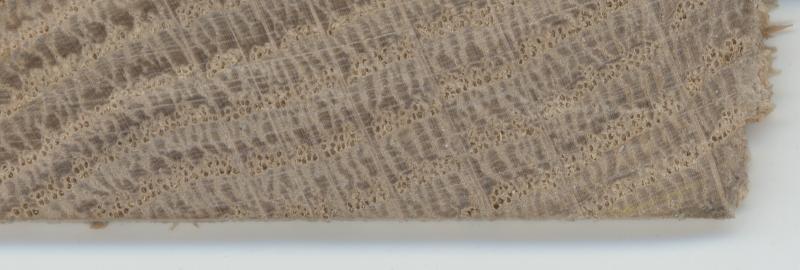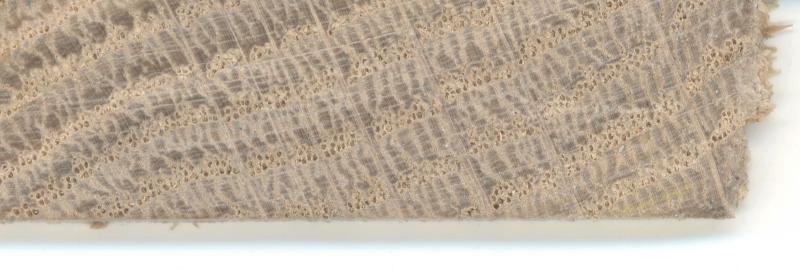Do I Have White or Red Oak?
Other Versions
Spanish
French
Woodweb wood detectives take on another case. April 30, 2009
Question
I have just about exhausted my research abilities, both here and everywhere else on the web, and am still not sure that I have the wood below identified. I believe it is white oak. When I cut a 3/32" slice off the end grain there are no holes through the pores in the early growth rings, but the pores do show as having one end open in some of the cut areas. I do not have any sodium nitrite (I will order some first chance), so I am reduce to posting a photo and begging for opinions. This is a 3/32" thick slice off the end of a sample board. I have no bark, no leaves, or no acorns to assist.

Click here for higher quality, full size image
Forum Responses
(Sawing and Drying Forum)
From contributor R:
Red oak is red and that looks brown so it must be white oak.
From contributor G:
I color balanced to get rid of the bluish cast. It still looks like white to me.

Click here for higher quality, full size image
From contributor Z:
The wood pores looks to be full of plugged objects. Cut 1/2" x1/2" x 3-4" in length and stick one end in soapy water and try to blow through the other end. I'd guess you cannot make air bubbles. On dried red oak you can blow through a small piece of wood.
From contributor N:
Good advice above. It looks like white oak to me too. The easiest diagnostic for red vs. white is ray length. Look at a transverse cut surface of board. If any of the rays are more than 1" long it's white oak.
From Gene Wengert, forum technical advisor:
Not all red oak is red in color; some can be fairly dark brown. Not all white oak is plugged; for example, chestnut oak can be blown through, but it is a white oak and there are others. The ray length test is excellent. In the archives here at WOODWEB, you will find this subject discussed with pictures. The second set of pictures shows the reddish color of white oak and also the ray length difference very clearly. (Just remember that white is a longer word the red, so white oak has longer rays.) Your sample picture does indeed seem to clearly show the occlusions of the pores (technical terms for "plugged"), so you have white oak.
Distinguishing White Oak from Red
From the original questioner:
Thank you all for your replies. They're much appreciated! I did indeed look at the rays, and in my boards there are some rays whose length exceeds the inch mark and even a few that are as much as 1-1/2" to 2" in length, but these are quite few while the majority are 1/2" to 1" in length. Unfortunately I didn't have another sample from a different tree to compare both rays and pores with.
Anyway, now I get to go back and remark all these freshly cut boards with "WO" instead of "RO" (and I don't mind that at all). These boards came from a couple of logs I cut recently. I got about 300bdft of mixed quartered and flatsawn 4/4 from two logs. About 2/3 of the boards are clear of defects of any kind while the rest have minimal knots as the only defects.
From contributor P:
Mr. Wengert can verify this method of ID. Maybe, somewhere someone told me that white oak leaves are not sharp pointed like the red oak species. Their tips are rounded so if you have a leaf near the tree one can verify the species.
From the original questioner:
I have also read about the difference in the leaf, and I recall that the source I was reading was government literature (like the USDA or similar). As I recall, the white oak has rounded leafs and the red oak has pointy leafs.
I would love to show a photo of the bark, or have a look at the leafs, but unfortunately, the slabs are all gone for firewood, and I only ever had the logs (part of a truckload of mixed hardwood sawlogs), so all I could do was look at the wood itself.
From Gene Wengert, forum technical advisor:
That is indeed correct about the leaves. Another helpful characteristic is that red oak acorns are very bitter, while white oak are sweeter. In fact, white oak acorns can be dried and made into flour and the bread baked with this flour will have a great nutty flavor. As an added feature, since most white oak acorns have a worm in them, you will also get you meat in every slice of bread.

